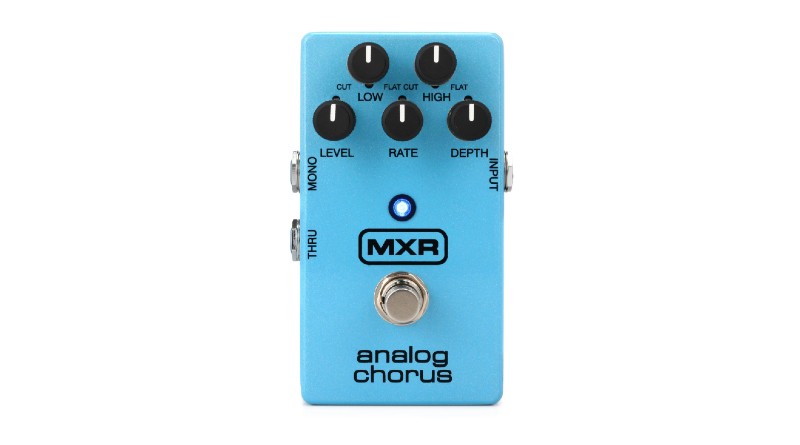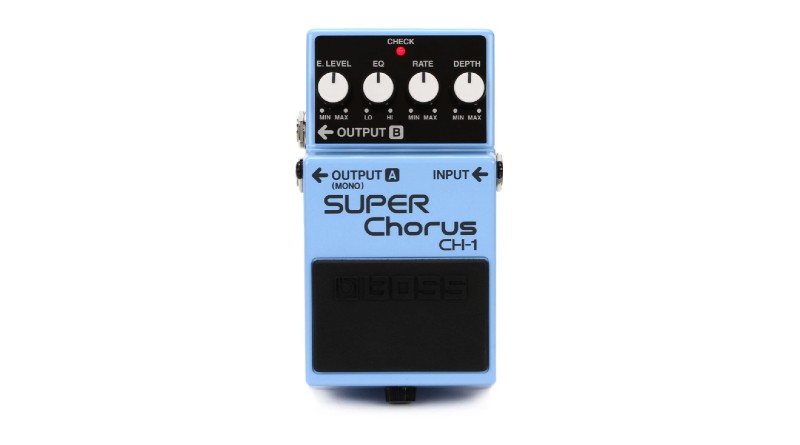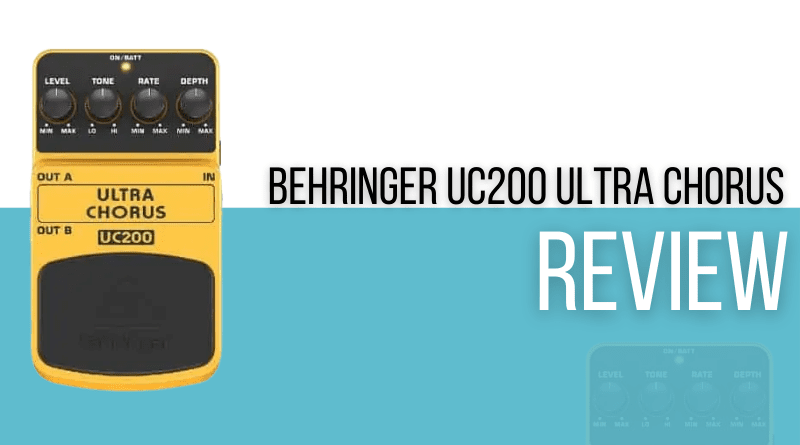If you follow the latest trends in guitar gear, there is a good chance that you’ve been seeing products from Behringer coming up with increasing frequency, in particular, their range of budget pedals.
These pedals are usually closely aligned with famous models from big name manufacturers. The pedal we’re looking at today, the Behringer UC200 Ultra Chorus, was clearly inspired by the extremely popular Boss CH-1 Super Chorus. Our experience of these Behringer models to date has been overwhelmingly positive, so we were excited to see what the UC200 could do.
Keep reading to find out how we got on with this pedal.
Read more about our review process.
Contents
Behringer UC200 Ultra Chorus: Who Is This Pedal For?
The Behringer UC200 Ultra Chorus is a great pedal for all players, from beginner to advanced. As with all Behringer pedals, it retails at an incredibly low price point, making it not only useful for all players, but also affordable at any budget.
Chorus pedals like this Behringer are great for players looking to get a fuller sound. Chorus works by doubling the input signal and slightly altering the pitch and timing of the secondary signal, giving the impression that a second guitar is playing.
Behringer UC200 Ultra Chorus: Appearance / Features / Controls
As with many of the Behringer clone pedals, the UC200 is functionally identical to the pedal that inspired it (in this case the Boss CH-1). However, aesthetically, it does have some notable differences. First of all, the Behringer is made with a bright yellow plastic body.
Behringer has gained some notoriety for the use of plastic, but most of the anti-plastic sentiment seems to come from those who have never had their hands on their pedals. We’re happy to report that while perhaps not as robust as a metal pedal, the UC200 is more than sturdy enough for most players.
The controls are laid out horizontally with 4 rotary dials, taking care of level, tone, rate, and depth. Level controls the volume of the chorus effect against the dry signal. The tone dial is a rudamentary EQ, allowing you to put bias towards bass or treble frequencies. Rate lets you control the speed of the chorus. Finally, depth is the knob that controls the subtlety of the chorus effect, from barely there, to in your face.
The UC200 also features a single input, and 2 outputs, allowing for true stereo, and with that, a much more engaging and authentic chorus effect.
Behringer UC200 Ultra Chorus: Performance / Sound
To get going we installed a fresh 9v battery into this Behringer pedal. As with the other Behringer FX pedals we’ve reviewed, the battery compartment on the UC200 was much harder than it needed to be to access. Unlike the Boss equivalent, on which the battery compartment can be accessed without tools, the Behringer does require 2 narrow implements in order to remove the cover. Once we had power to the pedal, it was time to fire it up.
Our first observation was just how quiet this pedal was. We’ve played a number of other chorus pedals, many more expensive than this model, yet the Behringer really stood out.
To see what the UC200 was like with base settings, we put all 4 dials to the noon position. It sounded just like a chorus pedal should with these settings. It had lots of presence, and sounded very natural, very full and very rich, with enough warble to keep it interesting.
Next, we kept the level and tone at the noon position, then moved rate and depth to around 3 o clock. The tone became much more warbly with these settings. It sounded less organic, but that’s not a bad thing if you’re going for a more supernatural sound.
We really wanted to see what would happen with rate and depth set to max, so, of course that was next up. With these settings, the rotation of the effect became much too extreme for rhythm use, but it did give us some very cool tones for soloing – think Nirvana’s ‘Come As You Are’ riff for reference.
The tone control really let us set the mod with this pedal. When we turned it down to bass bias, the UC200 gave us real 90s grunge energy. Very dark and brooding, while still letting that ethereal warble shine through. When we set it to the treble side, the chorus effect became bright and shimmery.
Finally, we gave the Behringer UC200 a try with the true stereo settings by hooking it up to 2 amps using both the A and B outputs. This really is the ultimate setup for chorus pedals, with the dry signal going to one amp, and the modified signal going to another. By setting each amp up on either side of the room, the stereo effect really felt like there was 2 guitarists playing simultaneously, giving us a very Thin Lizzy type of sound.
Other Chorus Pedals to Consider
We really did enjoy playing this Behringer Ultra Chorus, but if you’re looking for either a more heavy duty pedal, or a slightly different sound, you might want to take a look at these alternatives:
MXR M234 Analog Chorus

The MXR M234 Analog Chorus is Slash’s chorus pedal of choice, which is high enough praise on its own. Besides the endorsement of Slash, this MXR pedal offers a hard wearing, metal housing, as well as separate high and low frequency cut knobs for precision tone control. It has a compact form factor, and sounds absolutely incredible.
Boss CH-1 Super Chorus

Widely regarded as the most popular chorus pedal on the market, the Boss CH-1 has set the standard for others to follow. As we know, the Behringer Ultra Chorus was modeled after this pedal, but what you’ll get from the Boss that the Behringer won’t give you is a metal housing and a tool free battery changing experience. Tonally, it is almost indistinguishable from the Behringer, but if you’re hard on gear and you’re afraid of breakage, this is a great option.
Final Thoughts on the Behringer UC200 Ultra Chorus
Chorus is one of the must have pedals for any guitarist building a board. It works well with other FX, and is versatile enough to use across almost every genre of music.
We particularly enjoyed playing this Behringer Chorus – the UC200 did everything that was asked of it and sounded excellent in the process. How a pedal sounds is the most important thing, and the fact that this budget model sounded just as good as the Boss equivalent, which incidentally costs over 4 times more, should reaffirm the theory that gear doesn’t have to be expensive to be great.
Check out these other articles you might like:


